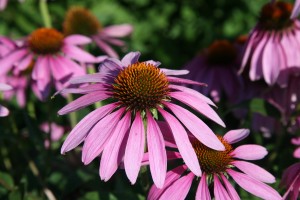Echinacea purpurea a herb. Several species of the echinacea plant are used to make medicine from its leaves, flower, and root.
Contents
Uses
Echinacea is believed by many people to stimulate the immune system. In indigenous medicine of the native American Indians, the plant is used externally for wounds, burns, and insect bites, chewing of roots for toothache and throat infections; internal application is used for pain, cough, stomach cramps and snake bites.
Benefits
Echinacea is widely used to fight infections, especially the common cold and other upper respiratory infections. Some people take echinacea at the first sign of a cold, hoping they will be able to keep the cold from developing. Other people take echinacea after cold symptoms have started, hoping they can make symptoms less severe. The people who use echinacea to treat symptoms have the right idea. Research to date shows that echinacea probably modestly reduces cold symptoms, but it’s not clear whether it helps prevent colds from developing.
Echinacea is also used against many other infections including the flu, urinary tract infections, vaginal yeast infections, genital herpes, bloodstream infections (septicemia), gum disease, tonsillitis, streptococcus infections, syphilis, typhoid, malaria, and diphtheria.
Other uses not related to infection include chronic fatigue syndrome (CFS), rheumatism, migraines, acid indigestion, pain, dizziness, rattlesnake bites, and attention deficit-hyperactivity disorder (ADHD).
Sometimes people apply echinacea to their skin to treat boils, abscesses, skin wounds, ulcers, burns, eczema, psoriasis, UV radiation skin damage, herpes simplex, bee stings, and hemorrhoids.
Cautions
- Echinacea is LIKELY SAFE for most people when used short-term. There is not enough information to know if echinacea is safe for long-term use. Some side effects have been reported such as fever, nausea, vomiting, unpleasant taste, stomach pain, diarrhea, sore throat, dry mouth, headache, numbness of the tongue, dizziness, insomnia, disorientation, and joint and muscle aches.Echinacea is POSSIBLY SAFE in children. It seems to be safe in most children ages 2-11 years. However, about 7% of these children may experience a rash that could be due to an allergic reaction. There is some concern that allergic reactions to echinacea could be more severe in some children. For this reason, some regulatory organizations have recommended against giving echinacea to children under 12 years of age.Echinacea is most likely to cause allergic reactions in children and adults who are allergic to ragweed, mums, marigolds, or daisies. If you have allergies, be sure to check with your healthcare provider before taking echinacea.Applying echinacea to the skin can cause redness, itchiness, or a rash.
Interactions
- Caffeine interacts with ECHINACEA
The body breaks down caffeine to get rid of it. Echinacea might decrease how quickly the body breaks down caffeine. Taking echinacea along with caffeine might cause too much caffeine in the bloodstream and increase the risk of side effects. Common side effects include jitteriness, headache, and fast heartbeat. - Medications changed by the body (Cytochrome P450 3A4 (CYP3A4) substrates) interacts with ECHINACEA
Some medications are changed and broken down by the body.
Echinacea might change how the body breaks down some medications. Taking echinacea along with some medications might increase the effects and side effects of some medications. Before taking echinacea, talk to your healthcare provider if you are taking any medications that are changed by the body.
Some medications changed by the body include lovastatin (Mevacor), clarithromycin (Biaxin), cyclosporine (Neoral, Sandimmune), diltiazem (Cardizem), estrogens, indinavir (Crixivan), triazolam (Halcion), and many others. - Medications changed by the liver (Cytochrome P450 1A2 (CYP1A2) substrates) interacts with ECHINACEA
Some medications are changed and broken down by the liver.
Echinacea might decrease how quickly the liver breaks down some medications.
Taking echinacea along with some medications might increase the effects and side effects of some medications. Before taking echinacea, talk to your healthcare provider if you are taking any medications that are changed by the liver.
Some of the medications that are changed by the liver include clozapine (Clozaril), cyclobenzaprine (Flexeril), fluvoxamine (Luvox), haloperidol (Haldol), imipramine (Tofranil), mexiletine (Mexitil), olanzapine (Zyprexa), pentazocine (Talwin), propranolol (Inderal), tacrine (Cognex), theophylline, zileuton (Zyflo), zolmitriptan (Zomig), and others. - Medications that decrease the immune system (Immunosuppressants) interacts with ECHINACEA
Echinacea can increase the immune system. Taking echinacea along with some medications that decrease the immune system might decrease the effectiveness of medications that decrease the immune system.
Some medications that decrease the immune system include azathioprine (Imuran), basiliximab (Simulect), cyclosporine (Neoral, Sandimmune), daclizumab (Zenapax), muromonab-CD3 (OKT3, Orthoclone OKT3), mycophenolate (CellCept), tacrolimus (FK506, Prograf), sirolimus (Rapamune), prednisone (Deltasone, Orasone), corticosteroids (glucocorticoids), and others.
Other names
American Cone Flower, Black Sampson, Black Susans, Brauneria Angustifolia, Brauneria Pallida, Comb Flower, Coneflower, Echinacea Angustifolia, Echinacea Pallida, Echinaceawurzel, Échinacée, Échinacée Angustifolia, Échinacée Pallida, Échinacée Pourpre, Échinacée Purpurea, Equinácea, Fleur à Hérisson, Hedgehog, Igelkopfwurzel, Indian Head, Kansas Snakeroot, Narrow-Leaved Purple Cone Flower, Pale Coneflower, Purple Cone Flower, Purpursonnenhutkraut, Purpursonnenhutwurzel, Racine d’echininacea, Red Sunflower, Rock-Up-Hat, Roter Sonnenhut, Rudbeckie Pourpre, Schmallblaettrige Kegelblumenwurzel, Schmallblaettriger Sonnenhut, Scurvy Root, Snakeroot, Sonnenhutwurzel
References
Source: WebMD, http://www.webmd.com/vitamins-supplements/ingredientmono-981-echinacea.aspx?activeingredientid=981&activeingredientname=echinacea
Wikipedia, https://en.wikipedia.org/wiki/Echinacea_purpurea

